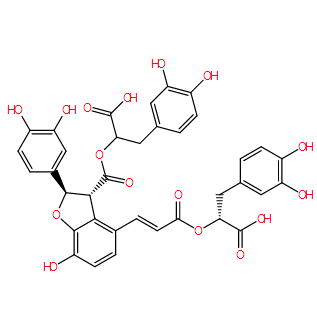| Cas No.: | 121521-90-2 |
| SMILES: | C1=CC(=C(C=C1C[C@H](C(=O)O)OC(=O)/C=C\C2=C3[C@H]([C@@H](OC3=C(C=C2)O)C4=CC(=C(C=C4)O)O)C(=O)O[C@H](CC5=CC(=C(C=C5)O)O)C(=O)O)O)O |
| Formula: | C36H30O16 |
| M.Wt: | 718.63 |
| Purity: | >98% |
| Sotrage: | 2 years -20°C Powder, 2 weeks 4°C in DMSO, 6 months -80°C in DMSO |
| Description: | Salvianolic acid B is an active ingredient of Salvia miltiorrhiza, which has been widely applied in China for the management of various microcirculation-related disorders, such as cardiovascular disease, cerebrovascular disease, and diabetic vascular complication. |
| In Vivo: | Salvianolic acid B (SalB) (5 mg · kg-1 · h-1) significantly attenuates LPS-induced pulmonary microcirculatory disturbance, including the increase in leukocyte adhesion and albumin leakage. In addition, LPS increases pulmonary tissue wet-to-dry weight ratio and tumor necrosis factor [alpha] and interleukin 8 levels in plasma and bronchoalveolar lavage fluid enhances the expression of E-selectin, intercellular adhesion molecule 1, myeloperoxidase, MMP-2, and MMP-9, whereas it decreases the expression of AQP-1 and AQP-5 in pulmonary tissue, all of which are attenuated by SalB pretreatment[1]. SalB administration (10 mg/kg) significantly ameliorate the Aβ25-35 peptide-induced memory impairment in the passive avoidance task (P<0.05). SalB treatment also reduced the number of activated microglia and astrocytes that are observed during the inflammatory reaction after the administration of the Aβ25-35 peptide. Moreover, SalB markedly reduce inducible nitric oxide synthase and cyclooxygenase-2 expression levels and thiobarbituric acid reactive substances, which are increased by the administration of the Aβ25-35 peptide. Furthermore, SalB administration significantly rescue the Aβ25-35 peptide-induced decrease of choline acetyltransferase and brain-derived neurotrophic factor protein levels[2]. |
| In Vitro: | Salvianolic acid B (SA-B) 1 and 10 micromol/L decrease the cell active TGF-beta1 secretion by 63.3 % and 15.6 % of the control, down-regulat pro-collgen alpha1(I) mRNA expression to 77.0% and 51.8% respectively (P<0.05). SA-B 1 and 10 micromol/L also inhibit MAPK activity by 1 to 2 fold respectively [3]. |
| References: | [1]. Lee YW, et al.Neuroprotective effects of salvianolic acid B on an Aβ25-35 peptide-induced mouse model of Alzheimer's disease. Eur J Pharmacol. 2013 Mar 15;704(1-3):70-7. [2]. Liu P, et al. Effect of salvianolic acid B on collagen production and mitogen-activated protein kinase activity in rat hepatic stellate cells. Acta Pharmacol Sin. 2002 Aug;23(8):733-8. [3]. Lin, Fang, et al. Salvianolic acid B protects from pulmonary microcirculation disturbance induced by lipopolysaccharide in rat. Shock. 2013 Mar;39(3):317-25. |

 DC Chemicals' products qualify for U.S. tariff exemptions. We guarantee no price increases due to customs duties and maintain stable supply, continuing to deliver reliable research solutions to our American clients.
DC Chemicals' products qualify for U.S. tariff exemptions. We guarantee no price increases due to customs duties and maintain stable supply, continuing to deliver reliable research solutions to our American clients.





















